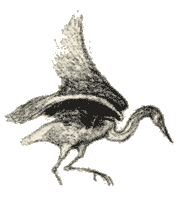This Month's Story

“Paul, stop! Back up!”
I stopped the pickup and backed to the small bridge draining the first of the two marsh lakes just north of the road.
“Look over there,” she pointed to an area at the far end of the lake.
We were out driving along Railroad Road north of Clermont Harbor. It was a Sunday kind of thing. We were looking in the several large marsh areas around Clermont Harbor in hopes of seeing some tricolor herons or maybe, with luck, a small blue. What she was pointing to was something completely unexpected.
White Pelicans!
About twenty or thirty of these extremely large birds were moving about behind a headland of marsh grass. They were feeding in a rather loose fashion; probably on fingerlings exiting from some small stream into the lake beyond the headland.
They made a grand sight and, as usual, I didn’t have my camera.

I don’t suppose there is any secret to my love of white pelicans. I have written before about how their brief visits are entwined in Stella and my lives. Unlike the brown pelicans, the white pelicans find the waters of the Sound too rough to do their paddle about fishing and so Stella and I seldom see them in front of our house. But the times we have seen them near the house and in other places in the area have been memorable.
Usually our sightings have been of groups of whites that range in numbers from a dozen or so birds to hundreds. As I said they are big. They have extraordinary wing spans of nine feet! The brown pelican is no slouch as to wing span, but it’s six or so feet spread is a third less than its cousin. I’m always impressed when I see them. The sighting of several hundred of these huge birds swimming in groups, taking off and landing and soaring high above in the sky is a startling spectacle. A great spread of wings, a feast for the eye of immense beauty.
Their presence in large groups is necessary for a practical reason. Whites don’t dive on their prey like the brown pelicans that we find so prevalent in the open waters of the Mississippi Sound, but rather they form a curved line in the water to flush their prey ahead of them and then, closing the circle, they dip their enormous beaks down and scoop up their meal. Hence their desire for calm water and the reason they are found in our back bayous and bays such as the marsh lake we were looking at the other Sunday.
I talked about all this recently to an amateur photographer friend, Mickey Ladner, remarking that when I do see a group of white pelicans, I invariably don’t have a camera and over a period of years have missed a great many superb photographs. Mickey is an a native of Bay St Louis. He went to school in the Bay and lived on Union Street. He now lives in Gulfport but still considers himself a Bay person.
After listening to my sorry tale, he said, “I have some great pictures of white pelicans. I’ve made a hobby of taking them and have a large collection, let me send you a few.”
And so, I recently received in the mail a CD from Mickey with the beautiful pictures that are shown on this page. He wrote saying that these were taken outside of Batesville, MS at the Sardis Dam spillway. The pictures are here for you to enjoy. They are, I will admit, far superior to any pictures of these beautiful birds than I would have taken. If you like them, you can thank Mickey for their splendid quality.
Look at them carefully.
I’ve been told that a number of large condominiums are to be built in the immediate area and that despite mitigating wetland rights, a great deal of the regional marsh is to be molded into a golf course. In may well be that the next time you want to see a tricolor heron, or a small blue heron or perhaps some of those magnificent white pelicans, you’ll have to go to the condominium’s air-cooled, exclusive club house.
There the club will have pictures of them in large, expensive frames over the leather chairs near the bar. Those pictures will have to satisfy you.
